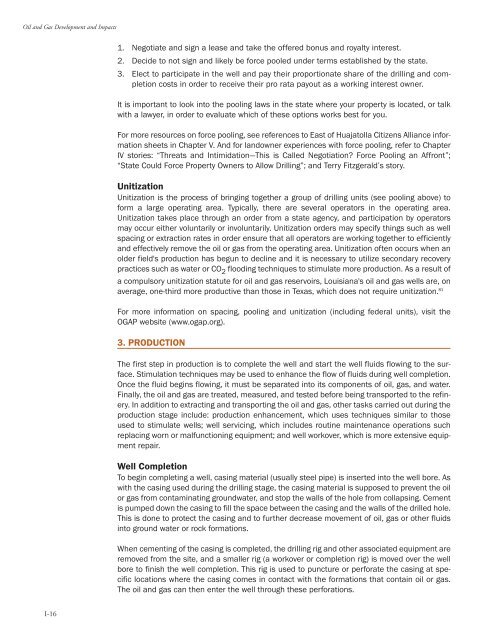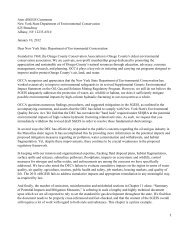Oil and Gas at Your Door? (2005 Edition) - Earthworks
Oil and Gas at Your Door? (2005 Edition) - Earthworks
Oil and Gas at Your Door? (2005 Edition) - Earthworks
You also want an ePaper? Increase the reach of your titles
YUMPU automatically turns print PDFs into web optimized ePapers that Google loves.
<strong>Oil</strong> <strong>and</strong> <strong>Gas</strong> Development <strong>and</strong> Impacts<br />
1. Negoti<strong>at</strong>e <strong>and</strong> sign a lease <strong>and</strong> take the offered bonus <strong>and</strong> royalty interest.<br />
2. Decide to not sign <strong>and</strong> likely be force pooled under terms established by the st<strong>at</strong>e.<br />
3. Elect to particip<strong>at</strong>e in the well <strong>and</strong> pay their proportion<strong>at</strong>e share of the drilling <strong>and</strong> completion<br />
costs in order to receive their pro r<strong>at</strong>a payout as a working interest owner.<br />
It is important to look into the pooling laws in the st<strong>at</strong>e where your property is loc<strong>at</strong>ed, or talk<br />
with a lawyer, in order to evalu<strong>at</strong>e which of these options works best for you.<br />
For more resources on force pooling, see references to East of Huaj<strong>at</strong>olla Citizens Alliance inform<strong>at</strong>ion<br />
sheets in Chapter V. And for l<strong>and</strong>owner experiences with force pooling, refer to Chapter<br />
IV stories: “Thre<strong>at</strong>s <strong>and</strong> Intimid<strong>at</strong>ion—This is Called Negoti<strong>at</strong>ion? Force Pooling an Affront”;<br />
“St<strong>at</strong>e Could Force Property Owners to Allow Drilling”; <strong>and</strong> Terry Fitzgerald’s story.<br />
Unitiz<strong>at</strong>ion<br />
Unitiz<strong>at</strong>ion is the process of bringing together a group of drilling units (see pooling above) to<br />
form a large oper<strong>at</strong>ing area. Typically, there are several oper<strong>at</strong>ors in the oper<strong>at</strong>ing area.<br />
Unitiz<strong>at</strong>ion takes place through an order from a st<strong>at</strong>e agency, <strong>and</strong> particip<strong>at</strong>ion by oper<strong>at</strong>ors<br />
may occur either voluntarily or involuntarily. Unitiz<strong>at</strong>ion orders may specify things such as well<br />
spacing or extraction r<strong>at</strong>es in order ensure th<strong>at</strong> all oper<strong>at</strong>ors are working together to efficiently<br />
<strong>and</strong> effectively remove the oil or gas from the oper<strong>at</strong>ing area. Unitiz<strong>at</strong>ion often occurs when an<br />
older field's production has begun to decline <strong>and</strong> it is necessary to utilize secondary recovery<br />
practices such as w<strong>at</strong>er or CO 2 flooding techniques to stimul<strong>at</strong>e more production. As a result of<br />
a compulsory unitiz<strong>at</strong>ion st<strong>at</strong>ute for oil <strong>and</strong> gas reservoirs, Louisiana's oil <strong>and</strong> gas wells are, on<br />
average, one-third more productive than those in Texas, which does not require unitiz<strong>at</strong>ion. 81<br />
For more inform<strong>at</strong>ion on spacing, pooling <strong>and</strong> unitiz<strong>at</strong>ion (including federal units), visit the<br />
OGAP website (www.ogap.org).<br />
3. PRODUCTION<br />
The first step in production is to complete the well <strong>and</strong> start the well fluids flowing to the surface.<br />
Stimul<strong>at</strong>ion techniques may be used to enhance the flow of fluids during well completion.<br />
Once the fluid begins flowing, it must be separ<strong>at</strong>ed into its components of oil, gas, <strong>and</strong> w<strong>at</strong>er.<br />
Finally, the oil <strong>and</strong> gas are tre<strong>at</strong>ed, measured, <strong>and</strong> tested before being transported to the refinery.<br />
In addition to extracting <strong>and</strong> transporting the oil <strong>and</strong> gas, other tasks carried out during the<br />
production stage include: production enhancement, which uses techniques similar to those<br />
used to stimul<strong>at</strong>e wells; well servicing, which includes routine maintenance oper<strong>at</strong>ions such<br />
replacing worn or malfunctioning equipment; <strong>and</strong> well workover, which is more extensive equipment<br />
repair.<br />
Well Completion<br />
To begin completing a well, casing m<strong>at</strong>erial (usually steel pipe) is inserted into the well bore. As<br />
with the casing used during the drilling stage, the casing m<strong>at</strong>erial is supposed to prevent the oil<br />
or gas from contamin<strong>at</strong>ing groundw<strong>at</strong>er, <strong>and</strong> stop the walls of the hole from collapsing. Cement<br />
is pumped down the casing to fill the space between the casing <strong>and</strong> the walls of the drilled hole.<br />
This is done to protect the casing <strong>and</strong> to further decrease movement of oil, gas or other fluids<br />
into ground w<strong>at</strong>er or rock form<strong>at</strong>ions.<br />
When cementing of the casing is completed, the drilling rig <strong>and</strong> other associ<strong>at</strong>ed equipment are<br />
removed from the site, <strong>and</strong> a smaller rig (a workover or completion rig) is moved over the well<br />
bore to finish the well completion. This rig is used to puncture or perfor<strong>at</strong>e the casing <strong>at</strong> specific<br />
loc<strong>at</strong>ions where the casing comes in contact with the form<strong>at</strong>ions th<strong>at</strong> contain oil or gas.<br />
The oil <strong>and</strong> gas can then enter the well through these perfor<strong>at</strong>ions.<br />
I-16




